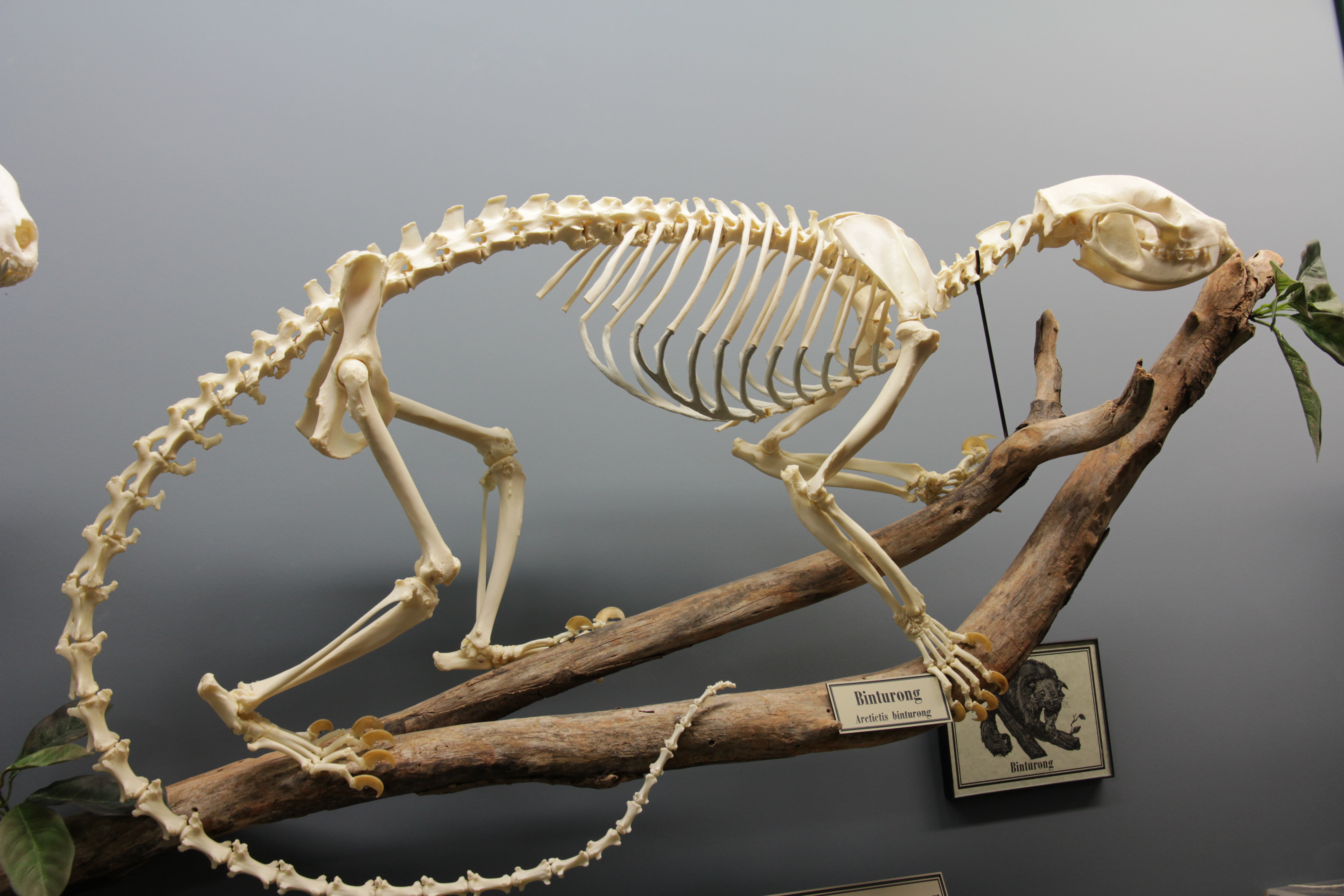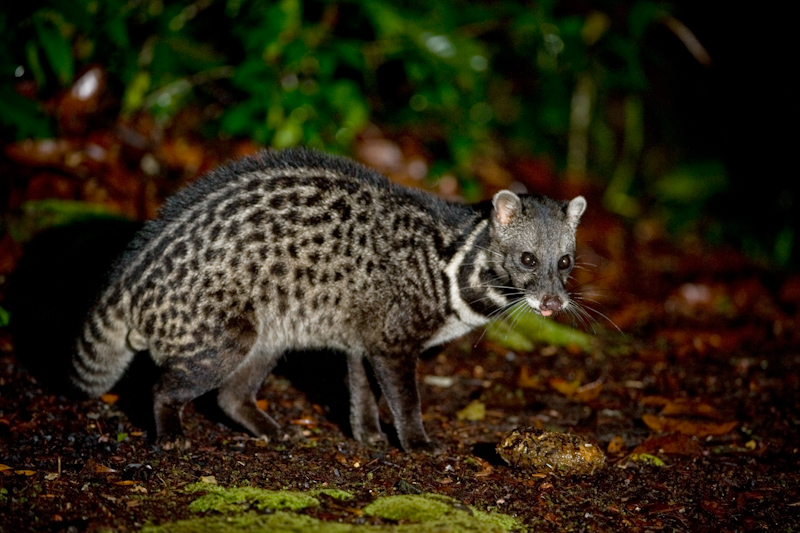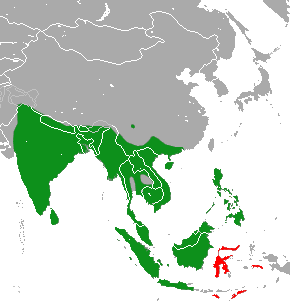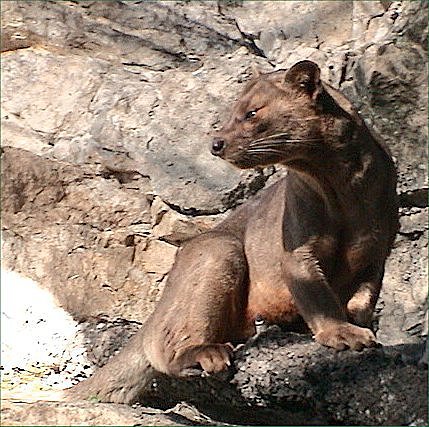|
Viverridae
Viverridae is a family (biology), family of small to medium-sized feliform mammals, comprising 14 genera with 33 species. This family was named and first described by John Edward Gray in 1821. Viverrids occur all over Africa, in southern Europe, South Asia, South and Southeast Asia on both sides of the Wallace Line. The word viverridae comes from the Latin word . The species of the subfamily Genettinae are known as Genet (animal), genets and Poiana (genus), oyans. The viverrids of the subfamily Viverrinae are commonly called civets; the Paradoxurinae and most Hemigalinae species are called palm civets. Characteristics Viverrids have four or five toes on each foot and half-retractile claws. They have six incisors in each jaw and Molar (tooth), molars with two tubercular grinders behind in the upper jaw, and one in the lower jaw. The tongue is rough with sharp prickles. A pouch or Anal gland, gland occurs beneath the anus, but there is no cecum. The male's Urinary meatus, urethr ... [...More Info...] [...Related Items...] OR: [Wikipedia] [Google] [Baidu] |
Genetta
A genet (pronounced or ) is a member of the genus ''Genetta'', which consists of 17 species of small African carnivorans. The common genet is the only genet present in Europe and occurs in the Iberian Peninsula, Italy and France. Genet fossils from the Late Miocene and later have been found at sites in Ethiopia, Kenya and Morocco. Classification ''Genetta'' was scientific name, named and described by Frédéric Cuvier in 1816. The number of species in the genus is controversial. The following were proposed as valid in 2005: Extinct species * ''Genetta nyakitongwer'' – Early Pleistocene of Kenya * ''Genetta plesictoides'' – Late Pleistocene of Cyprus ''Genetta'' and ''Poiana (genus), Poiana'' are estimated to have diverged about . ''Genetta'' species are estimated to have diverged at least starting with the Hausa genet, followed by the giant genet . Characteristics Genets are slender cat-like animals with a long body, a long ringed tail, large ears, a pointed muzzle ... [...More Info...] [...Related Items...] OR: [Wikipedia] [Google] [Baidu] |
Diplogale
Hose's palm civet (''Diplogale hosei''), also known as Hose's civet, is a viverrid species endemic to the island of Borneo. It is listed on the IUCN Red List as Vulnerable species, Vulnerable because of an ongoing population decline, estimated to be more than 30% over the last three generations (inferred to be 15 years) and suspected to be more than 30% in the next three generations due to declines in population inferred from habitat destruction and environmental degradation, degradation. ''Diplogale'' is a Monotypic taxon, monospecific genus (biology), genus. Hose's palm civet was named after the zoologist Charles Hose by Oldfield Thomas in 1892. Hose collected the first specimen in Sarawak in 1891. What little is known of the species comes primarily from 17 museum specimens worldwide. Only in 1997, the first living specimen was obtained and released after two months. Hose's civet is not kept in captivity anywhere in the world. Characteristics The upperparts (from nose to tail ... [...More Info...] [...Related Items...] OR: [Wikipedia] [Google] [Baidu] |
Viverra
''Viverra'' is a mammalian genus that was first named and described by Carl Linnaeus in 1758 as comprising several species including the large Indian civet (''V. zibetha''). The genus was subordinated to the viverrid family by John Edward Gray in 1821. Characteristics ''Viverra'' species are distinguished externally from the other genera of the Viverrinae by the structure of the fore feet: the third and fourth digits have lobes of skin, which act as protective sheaths for the retractile claws. The pads of the feet are surrounded by hair. They have a long and narrow skull, with narrow, nearly parallel-sided, not strongly constricted waist. Their postorbital processes are small and a little in front of the middle point between the tip of the premaxillae in front and of the occipital crest behind. The sagittal crest is moderately strong in adults. The sub-orbital portion of the cheek is comparatively short. The suture between the anterior bone of the zygomatic arch and the maxil ... [...More Info...] [...Related Items...] OR: [Wikipedia] [Google] [Baidu] |
Arctogalidia
The small-toothed palm civet (''Arctogalidia trivirgata''), also known as the three-striped palm civet, is a viverrid native to dense forests of Southeast Asia and some of the easternmost parts of South Asia (Northeast India), from the Assam state of India to Indochina, Malay Peninsula, and Singapore, and on Sumatra, Bangka, Java, Borneo, and numerous small nearby islands of Indonesia. The first scientific description by John Edward Gray in 1832 was based on a zoological specimen from the Maluku Islands in the collection of the Rijksmuseum van Natuurlijke Historie in Leiden, Netherlands. It is blackish grey, has black paws and three black longitudinal stripes on the back. A monotypic genus, ''Arctogalidia'' means ‘bear-weasel’ (from ancient Greek '' arkto-'' ‘bear’ + ''galidia'' ‘little weasel’). The specific epithet ''trivirgata'' means ‘three-striped’ in Latin. The small-toothed palm civet is mid-sized by the standards of its family, weighing and measuring ... [...More Info...] [...Related Items...] OR: [Wikipedia] [Google] [Baidu] |
Arctictis
The binturong (''Arctictis binturong'') (, ), also known as the bearcat, is a viverrid native to South and Southeast Asia. It is uncommon in much of its range, and has been assessed as Vulnerable on the IUCN Red List because of a declining population. It is estimated to have declined at least 30% since the mid-1980s. The binturong is the only species in the genus ''Arctictis''. Etymology "Binturong" is its common name in Borneo, and is related to the Western Malayo-Polynesian root "ma-tuRun". In Riau, it is called "benturong" and "tenturun". The scientific name ''Arctictis'' means 'bear-weasel', from the Greek '' arkt-'' "bear" + '' iktis'' "weasel". Taxonomy ''Viverra binturong'' was the scientific name proposed by Thomas Stamford Raffles in 1822 for a specimen from Malacca. The generic name ''Arctictis'' was proposed by Coenraad Jacob Temminck in 1824. ''Arctictis'' is a monotypic taxon; its morphology is similar to that of members of the genera ''Paradoxurus'' and ''Paguma ... [...More Info...] [...Related Items...] OR: [Wikipedia] [Google] [Baidu] |
Binturong
The binturong (''Arctictis binturong'') (, ), also known as the bearcat, is a viverridae, viverrid native to South Asia, South and Southeast Asia. It is uncommon in much of its range, and has been assessed as Vulnerable species, Vulnerable on the IUCN Red List because of a declining population. It is estimated to have declined at least 30% since the mid-1980s. The binturong is the only species in the genus ''Arctictis''. Etymology "Binturong" is its common name in Borneo, and is related to the Western Malayo-Polynesian languages, Malayo-Polynesian root "ma-tuRun". In Riau, it is called "benturong" and "tenturun". The scientific name ''Arctictis'' means 'bear-weasel', from the Greek '':wikt:ἄρκτος, arkt-'' "bear" + '':wikt:ἴκτις, iktis'' "weasel". Taxonomy ''Viverra binturong'' was the scientific name proposed by Thomas Stamford Raffles in 1822 for a specimen from Malacca. The generic name ''Arctictis'' was proposed by Coenraad Jacob Temminck in 1824. ''Arctictis'' ... [...More Info...] [...Related Items...] OR: [Wikipedia] [Google] [Baidu] |
Species
A species () is often defined as the largest group of organisms in which any two individuals of the appropriate sexes or mating types can produce fertile offspring, typically by sexual reproduction. It is the basic unit of Taxonomy (biology), classification and a taxonomic rank of an organism, as well as a unit of biodiversity. Other ways of defining species include their karyotype, DNA sequence, morphology (biology), morphology, behaviour, or ecological niche. In addition, palaeontologists use the concept of the chronospecies since fossil reproduction cannot be examined. The most recent rigorous estimate for the total number of species of eukaryotes is between 8 and 8.7 million. About 14% of these had been described by 2011. All species (except viruses) are given a binomial nomenclature, two-part name, a "binomen". The first part of a binomen is the name of a genus to which the species belongs. The second part is called the specific name (zoology), specific name or the specific ... [...More Info...] [...Related Items...] OR: [Wikipedia] [Google] [Baidu] |
Africa
Africa is the world's second-largest and second-most populous continent after Asia. At about 30.3 million km2 (11.7 million square miles) including adjacent islands, it covers 20% of Earth's land area and 6% of its total surface area.Sayre, April Pulley (1999), ''Africa'', Twenty-First Century Books. . With nearly billion people as of , it accounts for about of the world's human population. Demographics of Africa, Africa's population is the youngest among all the continents; the median age in 2012 was 19.7, when the worldwide median age was 30.4. Based on 2024 projections, Africa's population will exceed 3.8 billion people by 2100. Africa is the least wealthy inhabited continent per capita and second-least wealthy by total wealth, ahead of Oceania. Scholars have attributed this to different factors including Geography of Africa, geography, Climate of Africa, climate, corruption, Scramble for Africa, colonialism, the Cold War, and neocolonialism. Despite this lo ... [...More Info...] [...Related Items...] OR: [Wikipedia] [Google] [Baidu] |
Genera
Genus (; : genera ) is a taxonomic rank above species and below family as used in the biological classification of living and fossil organisms as well as viruses. In binomial nomenclature, the genus name forms the first part of the binomial species name for each species within the genus. :E.g. '' Panthera leo'' (lion) and '' Panthera onca'' (jaguar) are two species within the genus '' Panthera''. ''Panthera'' is a genus within the family Felidae. The composition of a genus is determined by taxonomists. The standards for genus classification are not strictly codified, so different authorities often produce different classifications for genera. There are some general practices used, however, including the idea that a newly defined genus should fulfill these three criteria to be descriptively useful: # monophyly – all descendants of an ancestral taxon are grouped together (i.e. phylogenetic analysis should clearly demonstrate both monophyly and validity as a separate lineag ... [...More Info...] [...Related Items...] OR: [Wikipedia] [Google] [Baidu] |
Paradoxurinae
Paradoxurinae is a subfamily of the feliform Viverridae, viverrids that was denominated and first described by John Edward Gray in 1864. Reginald Innes Pocock, Pocock subordinated the Genus (biology), genera ''Paradoxurus'', ''Paguma'' and ''Arctictis'' to this subfamily. Classification Living species Phylogenetic tree The phylogenetic relationships of Paradoxurinae are shown in the following cladogram: Extinct genera *''Kichechia'' *''Tugenictis'' *''Kanuites'' *''Siamictis'' References Viverrids Taxa named by John Edward Gray Long stubs with short prose {{carnivora-stub ... [...More Info...] [...Related Items...] OR: [Wikipedia] [Google] [Baidu] |
Feliform
Feliformia is a suborder within the order Carnivora consisting of "cat-like" carnivorans, including cats (large and small), hyenas, mongooses, viverrids, and related taxa. Feliformia stands in contrast to the other suborder of Carnivora, Caniformia consisting of "dog-like" carnivorans (includes Canoidea). The separation of the Carnivora into the broad groups of feliforms and caniforms is widely accepted, as is the definition of Feliformia and Caniformia as suborders (sometimes superfamilies). The classification of feliforms as part of the Feliformia suborder or under separate groupings continues to evolve. Systematic classifications dealing with only extant taxa include all feliforms into the Feliformia suborder, though variations exist in the definition and grouping of families and genera.Taxonomic references - extant species (1): Supporting descriptive information and picturesDiversity Web (online) – Feliformia/ref>Taxonomic references - extant species (2)Integrated Taxo ... [...More Info...] [...Related Items...] OR: [Wikipedia] [Google] [Baidu] |
Family (biology)
Family (, : ) is one of the eight major hierarchical taxonomic ranks in Linnaean taxonomy. It is classified between order and genus. A family may be divided into subfamilies, which are intermediate ranks between the ranks of family and genus. The official family names are Latin in origin; however, popular names are often used: for example, walnut trees and hickory trees belong to the family Juglandaceae, but that family is commonly referred to as the "walnut family". The delineation of what constitutes a family—or whether a described family should be acknowledged—is established and decided upon by active taxonomists. There are not strict regulations for outlining or acknowledging a family, yet in the realm of plants, these classifications often rely on both the vegetative and reproductive characteristics of plant species. Taxonomists frequently hold varying perspectives on these descriptions, leading to a lack of widespread consensus within the scientific community ... [...More Info...] [...Related Items...] OR: [Wikipedia] [Google] [Baidu] |









